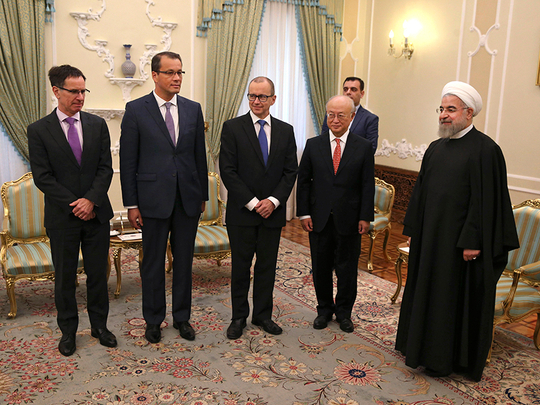
Tehran: The UN atomic watchdog on Sunday started a second day of talks in Tehran on safeguards to enhance transparency on Iran’s nuclear drive and on allegations of its past weapons work.
The talks were expected to continue into the afternoon, after a first day of meetings was described as “constructive” by Iran’s atomic organisation spokesman, Behrouz Kamalvandi.
Iranian media have reported little details of the negotiations with the Vienna-based International Atomic Energy Agency (IAEA).
And there has been no comment from the IAEA team, comprised of chief inspector Tero Varjoranta and four experts who arrived in Tehran late Friday.
But the encounter is expected to broach allegations that Iran’s nuclear work before 2003, or possibly since, had “possible military dimensions”.
The IAEA is also seeking access — which it has been denied for years — to the Parchin military facility where it suspects Tehran may have experimented with research related to atomic weapons development.
IAEA experts held five hours of talks Saturday with Iranian nuclear officials, led by Tehran’s IAEA envoy Reza Najafi, and assessed the implementation of a roadmap deal agreed on November 11.
The deal required Tehran to take six practical steps that included visits to the unfinished site of a so-called heavy water research reactor in Arak and a uranium mine in the south.
Also required from Iran was information on future research reactors, identifying sites of new nuclear power plants, and clarification on Iranian statements regarding additional enrichment facilities and laser enrichment technology.
Western powers and Israel suspect that Iran’s nuclear drive masks military objectives, a claim Tehran repeatedly denies.
Demands for full cooperation
The November deal, struck after two years of on-off talks, was separate from a landmark agreement reached with world powers the same month that has placed temporary curbs on Iran’s nuclear activities.
Implementation of the IAEA deal began in December, when inspectors visited Arak, where the small unfinished heavy water reactor has been hit by delays.
The site is of international concern because Iran could theoretically extract weapons-grade plutonium from spent fuel if it also builds a reprocessing facility.
Iran says it will continue work there but its atomic chief Ali Akbar Salehi has suggested the reactor could be modified to produce less plutonium to “allay the worries”.
The IAEA talks are running in parallel with efforts by the so-called P5+1 group of world powers seeking a comprehensive accord with Iran that would once and for all resolve the decade-long impasse over its nuclear work.
Under an interim deal agreed with the P5+1 on November 24, Iran has stopped enriching uranium to medium levels and is converting its current stockpile into a form much more difficult to process into weapons-grade material.
In exchange, Tehran has received limited relief from punishing sanctions imposed on it.
Verification of those curbing measures is delegated to the IAEA, forcing the agency to double the number of its inspectors and increase the frequency of visits to Iran’s nuclear facilities.
IAEA director general Yukiya Amano said last month that it was now the time to ask the “more difficult” questions.
How long this takes “very much depends on Iran. It can be quick or it can be long. It really depends on their cooperation,” he said.
Full cooperation with the IAEA is a key demand of the P5+1 — Britain, China, France, Russia and the US plus Germany.












